Modular E-Collar for Animal Telemetry: An Animal-Centered Design Proposal
Abstract
1. Introduction
2. Materials and Methods
2.1. Design Concept
- Strap: structural element on which the portability of the device is based;
- Electronic module: envelope that contains the active part of the device inside. In general, collars have a single electronic module that is placed in the lower part of the animal’s neck, allowing the antenna to be correctly oriented thanks to the action of gravity;
- Antenna: it is the component that allows the transmission of the information collected by the electronic device. The antenna can be external, a wire rope or a more sophisticated independent element such as the one in Figure 1, or internal, integrated into a printed circuit board (PCB);
- Coating: sometimes electronic modules and/or antennae are covered with plastic materials to protect them;
- Unions: the connection of the external elements with the strap is usually carried out by rivets or bolt–nut unions;
- Drop-Off: this is a mechanism used in the field of wildlife to be able to recover the device without having to recapture the animal that carries it. These devices can be electronic or mechanical. The latter are based on the degradation of the material that composes them; when the material has degraded in the expected time, the collar falls off and can be recovered by scientists;
- Closure system: the safest closures are made by means of two bolt–nut connections.
2.2. Design Methodology
2.2.1. Phase 1–Research (Diverge)
2.2.2. Phase 2–Define (Converge)
- Challenge 1 (Body—Strap): Choice of materials and strap size;
- Challenge 2 (Body—Modules): How can a watertight and flexible union of modules be made?
- Challenge 3 (Body—Modules): How can a cover–body joint of the module be watertight and safe?
- Challenge 4 (Body—Modules): How can the union or registration between the modules and the strap be made?
- Challenge 5 (Body—Modules): What should the shape of the modules be so that they do not cause discomfort to the animal?
- Challenge 6 (Body—Cover): How should the modules be protected?
- Challenge 7 (Drop-Off): Adaptation and development of a Drop-Off system based on the degradation of latex tubes;
- Challenge 8 (Closure): Proposal of a rapid closing system; and
- Challenge 9 (Distribution): Proposal of a correct distribution of the elements along the strap.
- Challenge 10 (Environmental conditions): Design of a collar resistant to environmental conditions;
- Challenge 11 (Integration): Design of a compact collar whose parts are integrated; and
- Challenge 12 (Impact): Design a collar that has the least impact on the animal.
2.2.3. Phase 3–Think and Prototype (Diverge)
2.2.4. Phase 4–Prototype and Test (Converge)
Sources
- Experts in the Environment (EE): Managers of animal centers and workers, who act as potential clients and animal experts. They work with the animals and put the collar on them;
- Research Experts (RE): Behavioral researchers, also acting as potential clients and experts in animal interaction in a context of behavioral research;
- Engineers (E), who evaluate technical specifications of the collar in the laboratory; and
- Current Offer (CO), which allows the proposed collar to be evaluated against current designs.
Methods
- Laboratory Experiments (LE): Laboratory tests were carried out at different times in the process to evaluate technical issues such as tightness. Rapid prototyping techniques were also used to evaluate the physical designs of the parts and the distribution of weights;
- Iterative Methods with users (IM): Regular contact with experts was maintained. Through various methods such as meetings, open interviews, small product presentations, sending samples, etc., information was extracted on their opinions and judgments. These methods guided the design process and allowed us to detect elements that should be emphasized in future evaluations;
- Focus Group (FG): A focus group was held with four experts in behavioral science with extensive experience with animals. The objective of the focus group was to gain the opinions that research experts have in relation to the proposals and what they can contribute to their work;
- Real-Life Testing (RLT): The prototypes were evaluated with animals, which allowed the designers to observe how they relate to the morphometry of the animal. On the other hand, experts in the environment also observed the behavior of animals in relation to the collars. The collars were tested on sheep (rasa aragonesa and roya bilbilitana), goats (murciano granadina and mestiza de Florida), and horses (hispano-bretón) under the approval of the Ethical Committee of the University of Zaragoza (PI55/20, 28 October 2020);
- Semi-Structured Interviews (SSI): Semi-structured interviews were carried out with the experts in the environment to evaluate the alternatives reflected in the prototypes, which are detailed later; and
- Document Analysis (DA): To evaluate the proposals against the current panorama on animal telemetry, a table was compiled in which the characteristics of different collars on the market were compared.
3. Results
3.1. Strap
3.2. Modules
3.2.1. Shell
3.2.2. Electronics
| Intensive Monitoring | Remote Monitoring | |
|---|---|---|
| Target animals | Small-medium sized mammals (sheep, goat, etc.) | Medium and large sized mammals (horse, cow, etc.) |
| Monitoring scenario | Animals are estabulated or in confined facilities that allow periodic check in. | Animals are free and move in large areas not seen for months. |
| Electronic blocks | 1 block with: Movement and magnetic sensor SD card for massive sensor datalogging, Bluetooth for communication and proximity sensing (Figure 7). | 3 blocks with: Movement sensor with smart analysis to extract activity. GPS (including antenna). Lora communication. |
| Battery | 6000 mA·h Li-Ion battery made up by 6 pieces of 1 A·h | 4000 mA·h Li-Ion battery made up by 4 pieces of 1 A·h |
| Energy expenditure | Low power (when no movement detected): 11.2 J/day Sensor datalogging (5’ proximity scan and 16 h of movement recorded): 663.5 J/day Data downloading (30’ once per day): 46.8 J/day | Low power (when no movement detected): 33.7 J/day Sensor data logging (1 h proximity scan and 2 h of movement recorded): 77.7 J/day GPS data logging (24 locations/day) and activity sending (1 h periodicity): 62.6 J/day GPS data logging (4 locations/day): 10.4 J/day |
| Device lifetime | 91 days | Smart mode (24 gps/day) + Activity + BLE --> 236 days Smart mode (4 gps/day) --> 5.5 years |
- Sensing, computing, and datalogging: these were implemented using a microcontroller (to manage data and rest of the hardware) and small sensors measuring linear and angular acceleration, sound, magnetic field, etc.
- Communications: these were implemented using different communication modules depending on the required range, data throughput, and antenna size (e.g., Bluetooth (short range, high throughput, smallest antenna), VHF (very long range, very little throughput, large antenna) and Lora (long range, low throughput, small antenna)).
- Location: this can be undertaken using a global navigation satellite system (GNSS) module for precise and global location or using wireless communication modules for rough positioning.
- Energy: battery is required to run the electronics and its technology and size defines the system’s lifetime by dividing the energy available inside the battery by the energy required by the electronics (calculated as the sum of the products of the power required by each electronic block inside the device times the time this piece is running).
3.3. Coating
3.4. Drop-Off
3.5. Closure
4. Discussion
4.1. Design Flexibility
4.2. Weight and Weight Distribution: Comfort and Autonomy
4.3. Structure
4.4. Unions
4.5. Closing System
4.6. Integration of the Elements
5. Conclusions
- Homogeneous distribution of weight in at least six modules;
- Three times lighter than devices on the market with the highest number of modules (2–3 modules);
- Design flexibility: modularity and 3D printing;
- Modular electronics on demand of the project with customizable functions;
- Extra-light unions with a reduced number of pieces (one piece per module compared to 6–8 on the market);
- Tightness and resistance to environmental conditions;
- Collar thickness of at least 50% less than that of commercial devices;
- Quick magnetic closure system;
- Wirelessly rechargeable batteries and homogeneous distribution on the collar in case of higher demand; and
- Formal adaptation to the requirements of the context and visually integrated elements.
Author Contributions
Funding
Institutional Review Board Statement
Informed Consent Statement
Data Availability Statement
Conflicts of Interest
References
- Talcott, M.R.; Akers, W.; Marini, R.P. Chapter 25—Techniques of Experimentation. In Laboratory Animal Medicine, 3rd ed.; Fox, J.G., Anderson, L.C., Otto, G.M., Pritchett-Corning, K.R., Whary, M.T., Eds.; American College of Laboratory Animal Medicine; Academic Press: Boston, MA, USA, 2015; pp. 1201–1262. ISBN 978-0-12-409527-4. [Google Scholar]
- Cochran, W.W.; Lord, R.D. A Radio-Tracking System for Wild Animals. J. Wildl. Manag. 1963, 27, 9. [Google Scholar] [CrossRef]
- Habib, B.; Shrotriya, S.; Sivakumar, K.; Sinha, P.R.; Mathur, V.B. Three Decades of Wildlife Radio Telemetry in India: A Review. Anim. Biotelemetry 2014, 2, 4. [Google Scholar] [CrossRef]
- Wilmers, C.C.; Nickel, B.; Bryce, C.M.; Smith, J.A.; Wheat, R.E.; Yovovich, V. The Golden Age of Bio-Logging: How Animal-Borne Sensors Are Advancing the Frontiers of Ecology. Ecology 2015, 96, 1741–1753. [Google Scholar] [CrossRef]
- Duran-Lopez, L.; Gutierrez-Galan, D.; Dominguez-Morales, J.P.; Rios-Navarro, A.; Tapiador-Morales, R.; Jimenez-Fernandez, A.; Cascado-Caballero, D.; Linares-Barranco, A. A Low-Power, Reachable, Wearable and Intelligent IoT Device for Animal Activity Monitoring. In Proceedings of the IJCCI 2019—Proceedings of the 11th International Joint Conference on Computational Intelligence, Vienna, Austria, 4–6 September 2019; pp. 516–521. [Google Scholar] [CrossRef]
- Jukan, A.; Masip-Bruin, X.; Amla, N. Smart Computing and Sensing Technologies for Animal Welfare: A Systematic Review. ACM Comput. Surv. 2017, 50, 1–27. [Google Scholar] [CrossRef]
- Muminov, A.; Sattarov, O.; Lee, C.W.; Kang, H.K.; Ko, M.C.; Oh, R.; Ahn, J.; Oh, H.J.; Jeon, H.S. Reducing GPS Error for Smart Collars Based on Animal’s Behavior. Appl. Sci. 2019, 9, 3408. [Google Scholar] [CrossRef]
- Nakagawa, K.; Kobayashi, H.H. Optimal Arrangement of Wearable Devices Based on Lifespan of Animals as Device Transporter Materials for Long-Term Monitoring of Wildlife Animal Sensor Network. Sens. Mater. 2020, 32, 13. [Google Scholar] [CrossRef]
- Neethirajan, S. Recent Advances in Wearable Sensors for Animal Health Management. Sens. Bio-Sens. Res. 2017, 12, 15–29. [Google Scholar] [CrossRef]
- Zhang, B.; Zhuang, L.; Qin, Z.; Wei, X.; Yuan, Q.; Qin, C.; Wang, P. A Wearable System for Olfactory Electrophysiological Recording and Animal Motion Control. J. Neurosci. Methods 2018, 307, 221–229. [Google Scholar] [CrossRef]
- Lahoz-Monfort, J.J.; Magrath, M.J.L. A Comprehensive Overview of Technologies for Species and Habitat Monitoring and Conservation. BioScience 2021, 71, 1038–1062. [Google Scholar] [CrossRef]
- Sugai, L.S.M. Pandemics and the Need for Automated Systems for Biodiversity Monitoring. J. Wildl. Manag. 2020, 84, 1424–1426. [Google Scholar] [CrossRef]
- Neethirajan, S. Transforming the Adaptation Physiology of Farm Animals through Sensors. Animals 2020, 10, 1512. [Google Scholar] [CrossRef]
- Helwatkar, A.; Riordan, D.; Walsh, J. Sensor Technology for Animal Health Monitoring. Int. J. Smart Sens. Intell. Syst. 2014, 7. [Google Scholar] [CrossRef]
- Neethirajan, S.; Kemp, B. Digital Livestock Farming. Sens. Bio-Sens. Res. 2021, 32, 100408. [Google Scholar] [CrossRef]
- Brandt, S.; Vassant, J.; Baubet, E. Adaptation d’un Collier Émetteur Extensible Pour Sanglier. Faune Sauvage 2004, 263, 13–18. [Google Scholar]
- Cid, B.; da Costa, R.d.C.; Balthazar, D.d.A.; Augusto, A.M.; Pires, A.S.; Fernandez, F.A.S. Preventing Injuries Caused by Radiotelemetry Collars in Reintroduced Red-Rumped Agoutis, Dasyprocta Leporina (Rodentia: Dasyproctidae), in Atlantic Forest, Southeastern Brazil. Zoologia 2013, 30, 115–118. [Google Scholar] [CrossRef][Green Version]
- Dick, B.L.; Findholt, S.L.; Johnson, B.K. A Self-Adjusting Expandable GPS Collar for Male Elk. Wildl. Soc. Bull. 2013, 37, 887–892. [Google Scholar] [CrossRef]
- Foley, C.J.; Sillero-Zubiri, C. Open-Source, Low-Cost Modular GPS Collars for Monitoring and Tracking Wildlife. Methods Ecol. Evol. 2020, 11, 553–558. [Google Scholar] [CrossRef]
- Haramis, G.M.; White, T.S. A Beaded Collar for Dual Micro GPS/VHF Transmitter Attachment to Nutria. Mammalia 2011, 75, 79–82. [Google Scholar] [CrossRef]
- Holzenbein, S. Expandable PVC Collar for Marking and Transmitter Support. J. Wildl. Manag. 1992, 56, 473. [Google Scholar] [CrossRef]
- Isbell, L.A.; Bidner, L.R.; Omondi, G.; Mutinda, M.; Matsumoto-Oda, A. Capture, Immobilization, and Global Positioning System Collaring of Olive Baboons (Papio anubis) and Vervets (Chlorocebus pygerythrus): Lessons Learned and Suggested Best Practices. Am. J. Primatol. 2019, 81, 22997. [Google Scholar] [CrossRef]
- Kolz, A.L.; Johnson, R.E. Self-Adjusting Collars for Wild Mammals Equipped with Transmitters. J. Wildl. Manag. 1980, 44, 273. [Google Scholar] [CrossRef]
- Smith, B.L.; Burger, W.P.; Singer, F.J. An Expandable Radiocollar for Elk Calves. Wildl. Soc. Bull. 1998, 26, 113–117. [Google Scholar]
- Dore, K.M.; Hansen, M.F.; Klegarth, A.R.; Fichtel, C.; Koch, F.; Springer, A.; Kappeler, P.; Parga, J.A.; Humle, T.; Colin, C.; et al. Review of GPS Collar Deployments and Performance on Nonhuman Primates. Primates 2020, 61, 373–387. [Google Scholar] [CrossRef]
- Trayford, H.R.; Farmer, K.H. An Assessment of the Use of Telemetry for Primate Reintroductions. J. Nat. Conserv. 2012, 20, 311–325. [Google Scholar] [CrossRef]
- Weaver, S.J.; Westphal, M.F.; Taylor, E.N. Technology Wish Lists and the Significance of Temperature-Sensing Wildlife Telemetry. Anim. Biotelemetry 2021, 9, 29. [Google Scholar] [CrossRef]
- Advanced Telemetry Systems G5-D Iridium/GPS Collar. Available online: https://atstrack.com/tracking-products/transmitters/G5D-Iridium-GPS-Collar.aspx (accessed on 19 October 2020).
- Advanced Telemetry Systems G2110E2 Iridium/GPS Collar. Available online: https://atstrack.com/tracking-products/transmitters/G2110E2-Iridium-GPS-Collar.aspx (accessed on 19 October 2020).
- Lotek Ultimate V6C Series. Available online: https://www.lotek.com/wp-content/uploads/2018/12/Ultimate-V6C-Series-Spec-Sheet.pdf (accessed on 30 October 2020).
- Lotek WildCell Series. Available online: https://www.lotek.com/wp-content/uploads/2018/05/WildCell-Series-Spec-Sheet.pdf (accessed on 30 October 2020).
- Lotek PinnaclePro Series. Available online: https://www.lotek.com/wp-content/uploads/2018/08/PinnaclePro-Series-Spec-Sheet.pdf (accessed on 30 October 2020).
- Telemetry Solutions Iridium GPS Collars. Available online: https://www.telemetrysolutions.com/wildlife-tracking-devices/gps-collars/iridium-gps-collars/ (accessed on 30 October 2020).
- Tellus Tellus GPS Collars. Available online: https://www.followit.se/files/folder/magazines/tellus/tellus_product_sheet.pdf (accessed on 30 October 2020).
- Telonics GPS/Iridium Terrestrial Systems. Available online: https://www.telonics.com/products/gps4/gps-iridium.php (accessed on 30 October 2020).
- Ixorigue GPS Ixotrack. Available online: https://ixorigue.com (accessed on 30 October 2020).
- Blanco, T.; Casas, R.; Manchado-Pérez, E.; Asensio, Á.; López-Pérez, J.M. From the Islands of Knowledge to a Shared Understanding: Interdisciplinarity and Technology Literacy for Innovation in Smart Electronic Product Design. Int. J. Technol. Des. Educ. 2017, 27, 329–362. [Google Scholar] [CrossRef]
- What Is the Framework for Innovation? Design Council’s Evolved Double Diamond. Available online: https://www.designcouncil.org.uk/news-opinion/what-framework-innovation-design-councils-evolved-double-diamond (accessed on 12 November 2020).
- IDEO.org IDEO Tools—Human Centered Design. Available online: https://www.ideo.org/tools (accessed on 12 November 2020).
- Insitute of Design at Stanford. An Introduction to Design Thinking PROCESS GUIDE. Available online: https://dschool-old.stanford.edu/sandbox/groups/designresources/wiki/36873/attachments/74b3d/ModeGuideBOOTCAMP2010L.pdf (accessed on 12 November 2020).
- Blanco, T. (Universidad de Zaragoza, Zaragoza, Spain). Cosica_Guía Didáctica Para El Diseño. 2020; Unpublished work. [Google Scholar]
- Blanco, T.; Casas, R.; Marín, J.; Marco, Á. (Universidad de Zaragoza, Zaragoza, Spain). Designing in the Internet of Things. A Multidisciplinary Instructional Methodology. 2020; Unpublished work. [Google Scholar]
- Blanco, T.; Berbegal, A.; Blasco, R.; Casas, R. Xassess: Crossdisciplinary Framework in User-Centred Design of Assistive Products. J. Eng. Des. 2016, 27, 636–664. [Google Scholar] [CrossRef]
- Brannen, J. Mixing Methods: The Entry of Qualitative and Quantitative Approaches into the Research Process. Int. J. Soc. Res. Methodol. 2005, 8, 173–184. [Google Scholar] [CrossRef]
- Lund, T. Combining Qualitative and Quantitative Approaches: Some Arguments for Mixed Methods Research. Scand. J. Educ. Res. 2012, 56, 155–165. [Google Scholar] [CrossRef]
- Telonics Telonics Breakways Collars. Available online: https://www.telonics.com/products/expansionBreakawayCollars/ (accessed on 30 October 2020).
- Frankfurter, G.; Beltran, R.S.; Hoard, M.; Burns, J.M. Rapid Prototyping and 3D Printing of Antarctic Seal Flipper Tags. Wildl. Soc. Bull. 2019, 43, 313–316. [Google Scholar] [CrossRef]
- Fischer, M.; Parkins, K.; Maizels, K.; Sutherland, D.R.; Allan, B.M.; Coulson, G.; Di Stefano, J. Biotelemetry Marches on: A Cost-Effective GPS Device for Monitoring Terrestrial Wildlife. PLoS ONE 2018, 13, e0199617. [Google Scholar] [CrossRef] [PubMed]
- Paci, P.; Mancini, C.; Price, B.A. Designing for Wearability. In Proceedings of the Sixth International Conference on Animal-Computer Interaction, Haifa, Israel, 12–14 November 2019; ACM: New York, NY, USA, 2019; pp. 1–12. [Google Scholar]
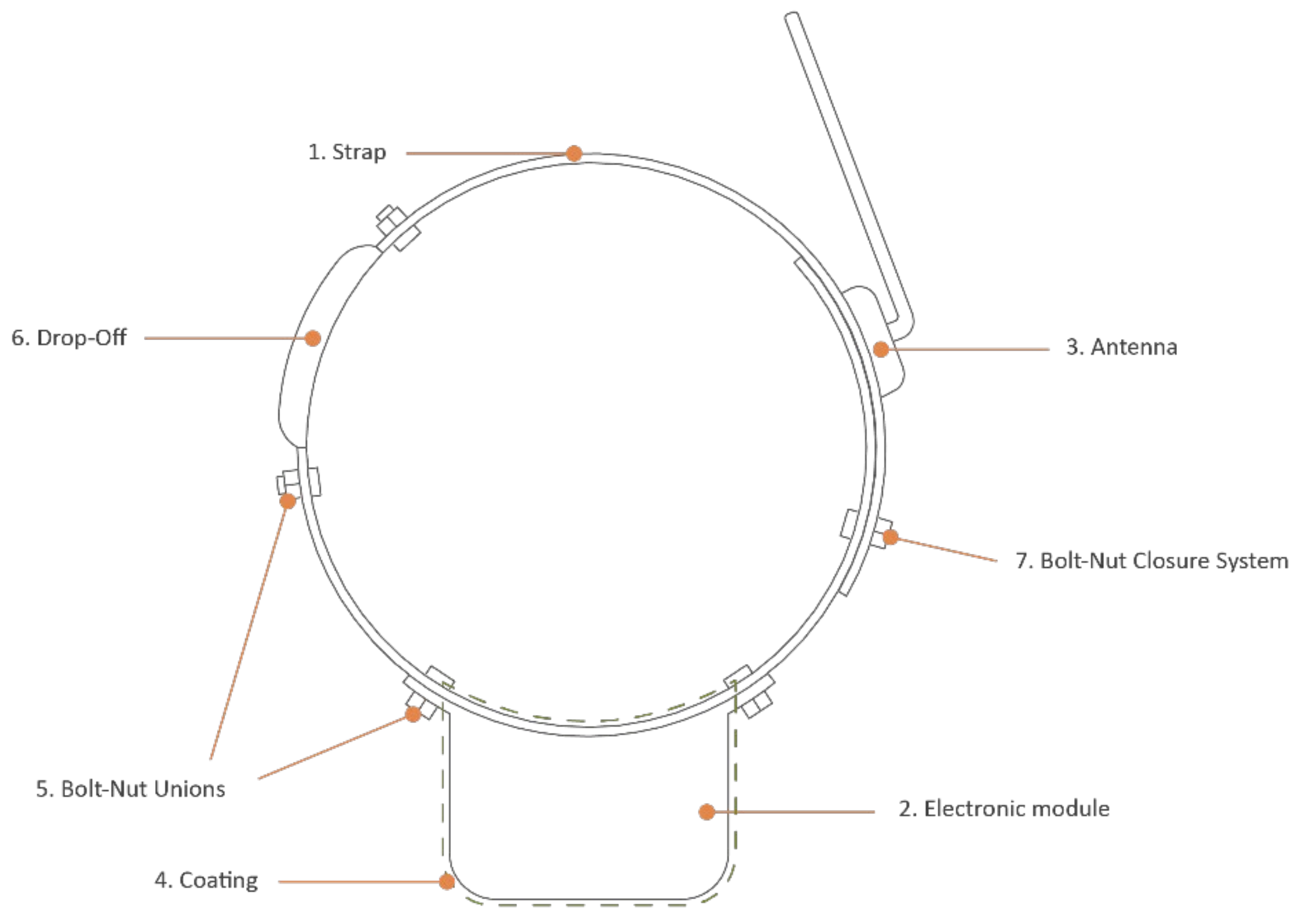
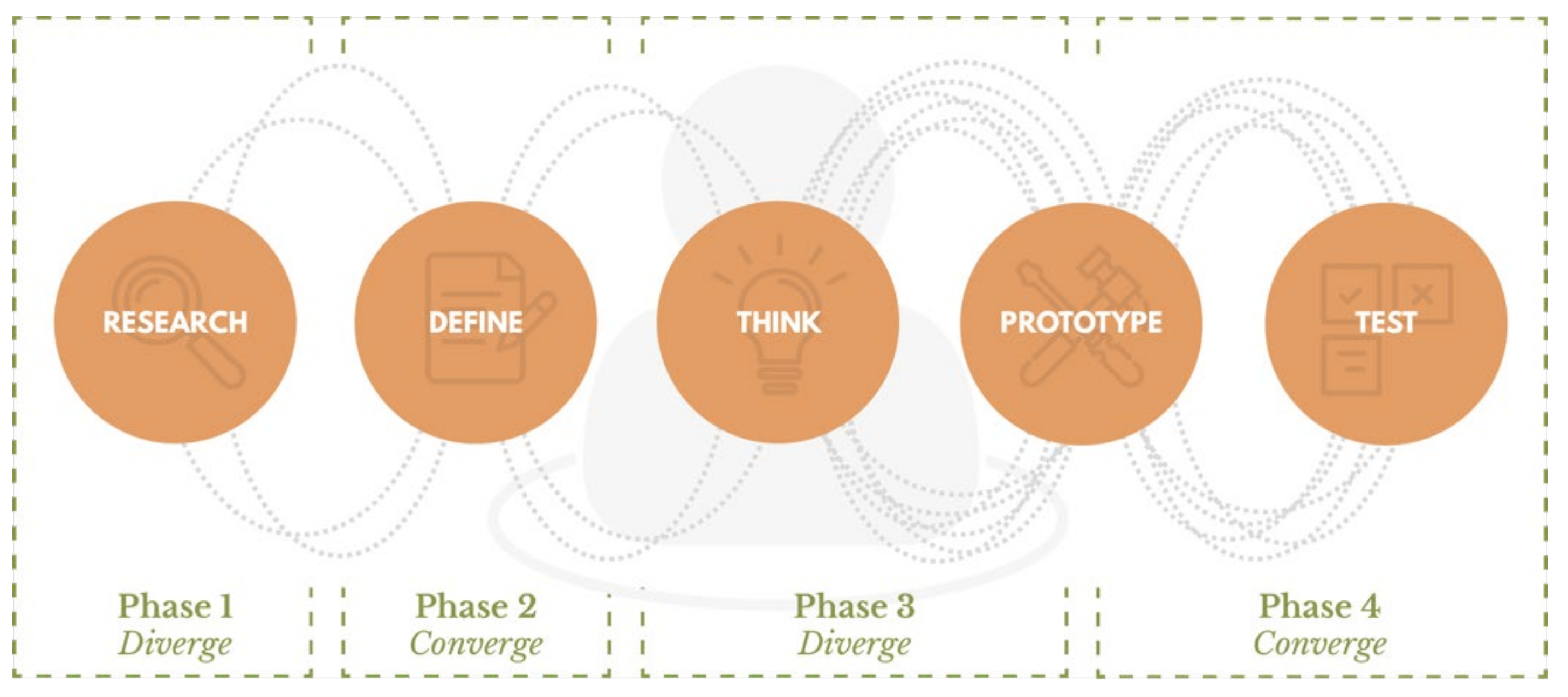

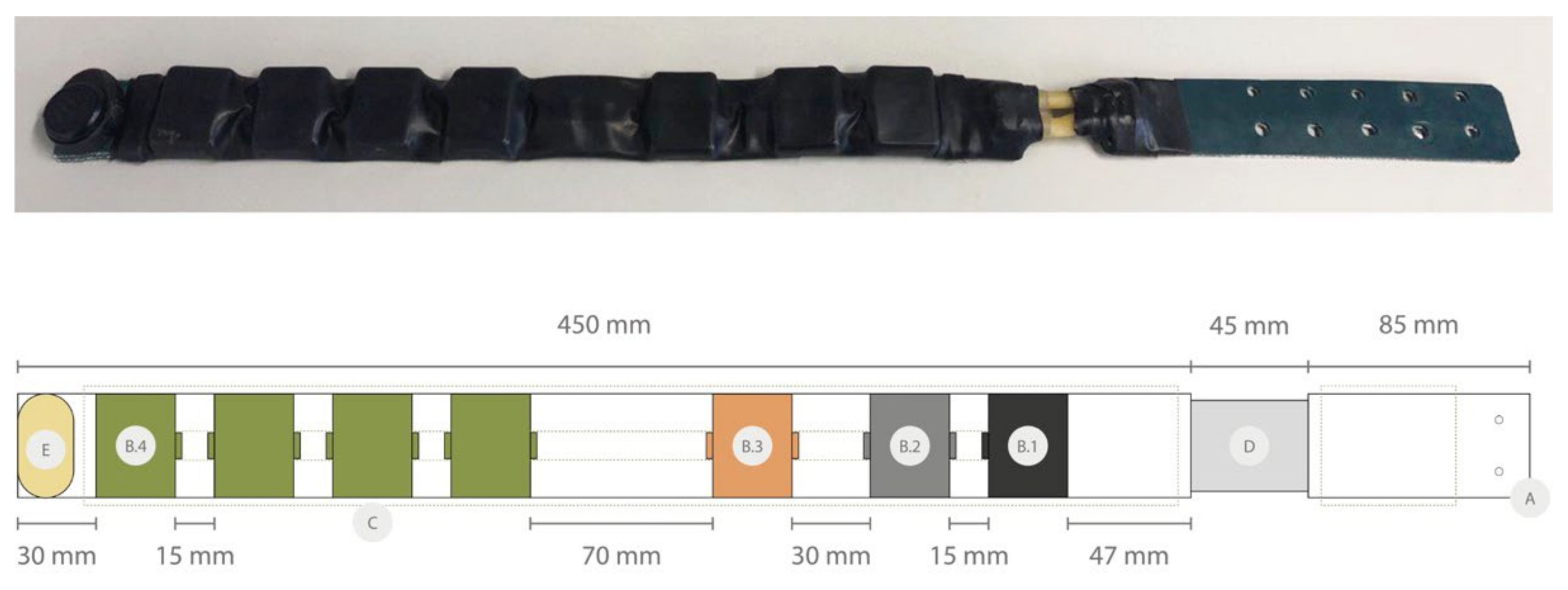
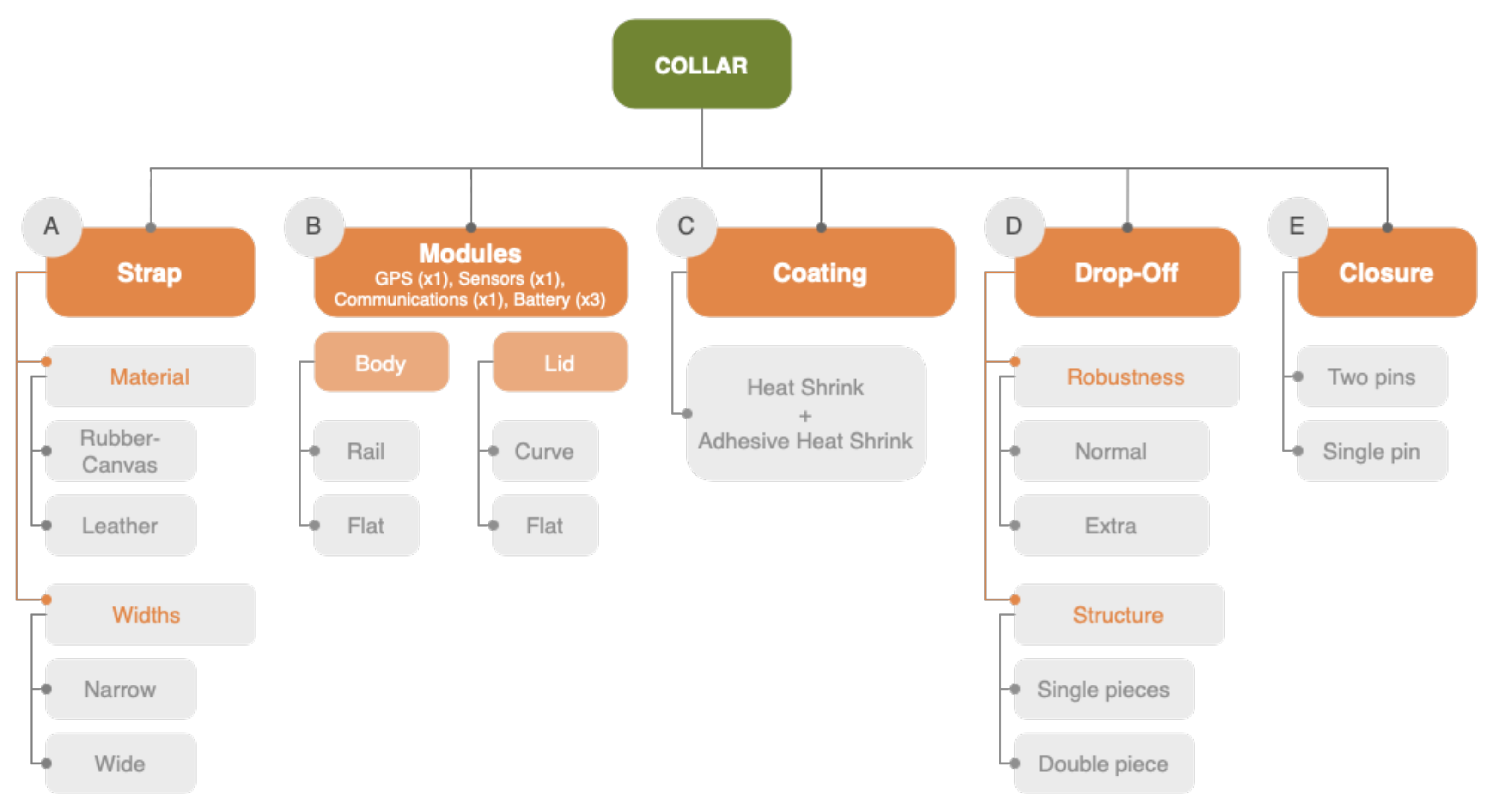
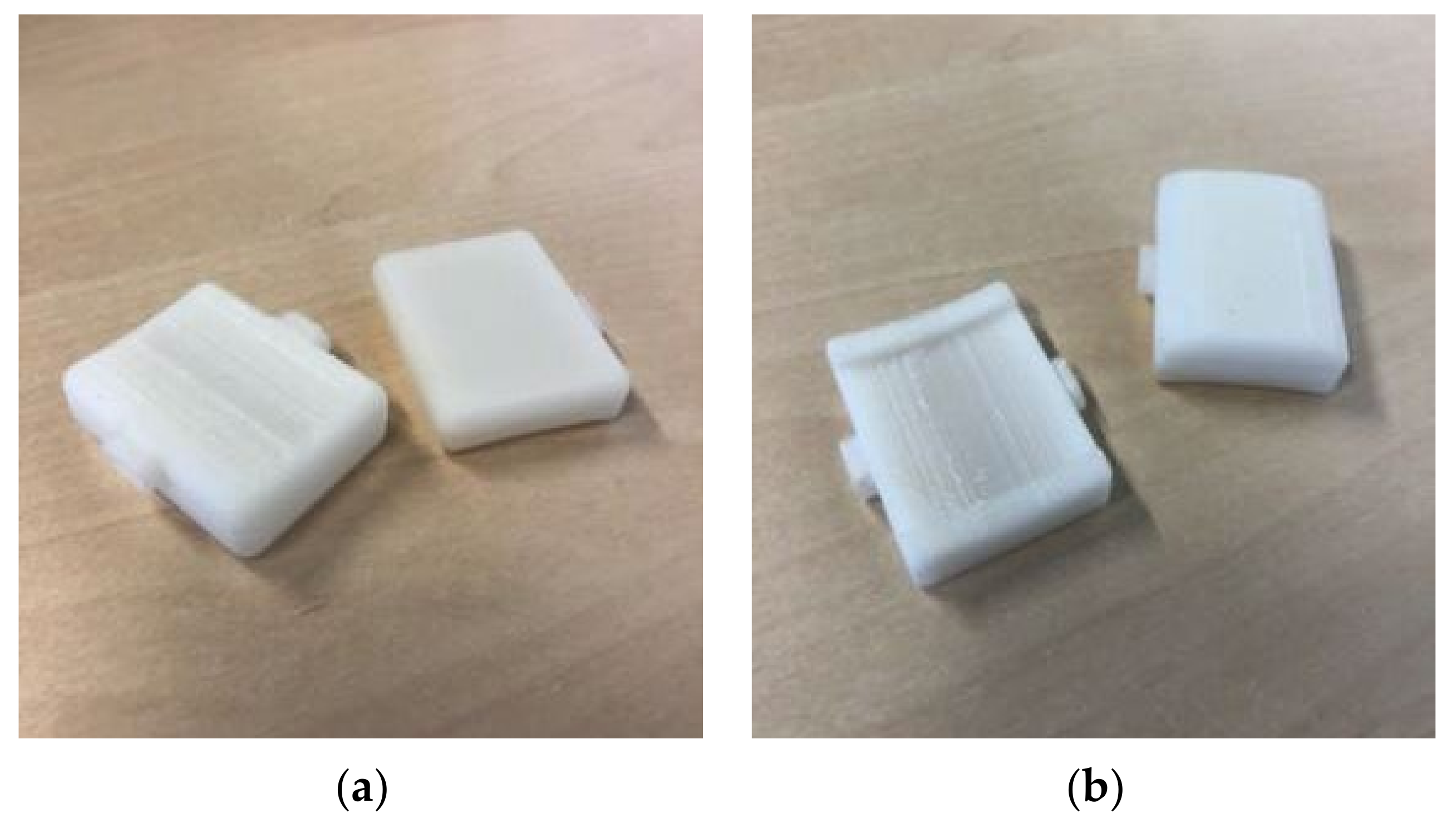
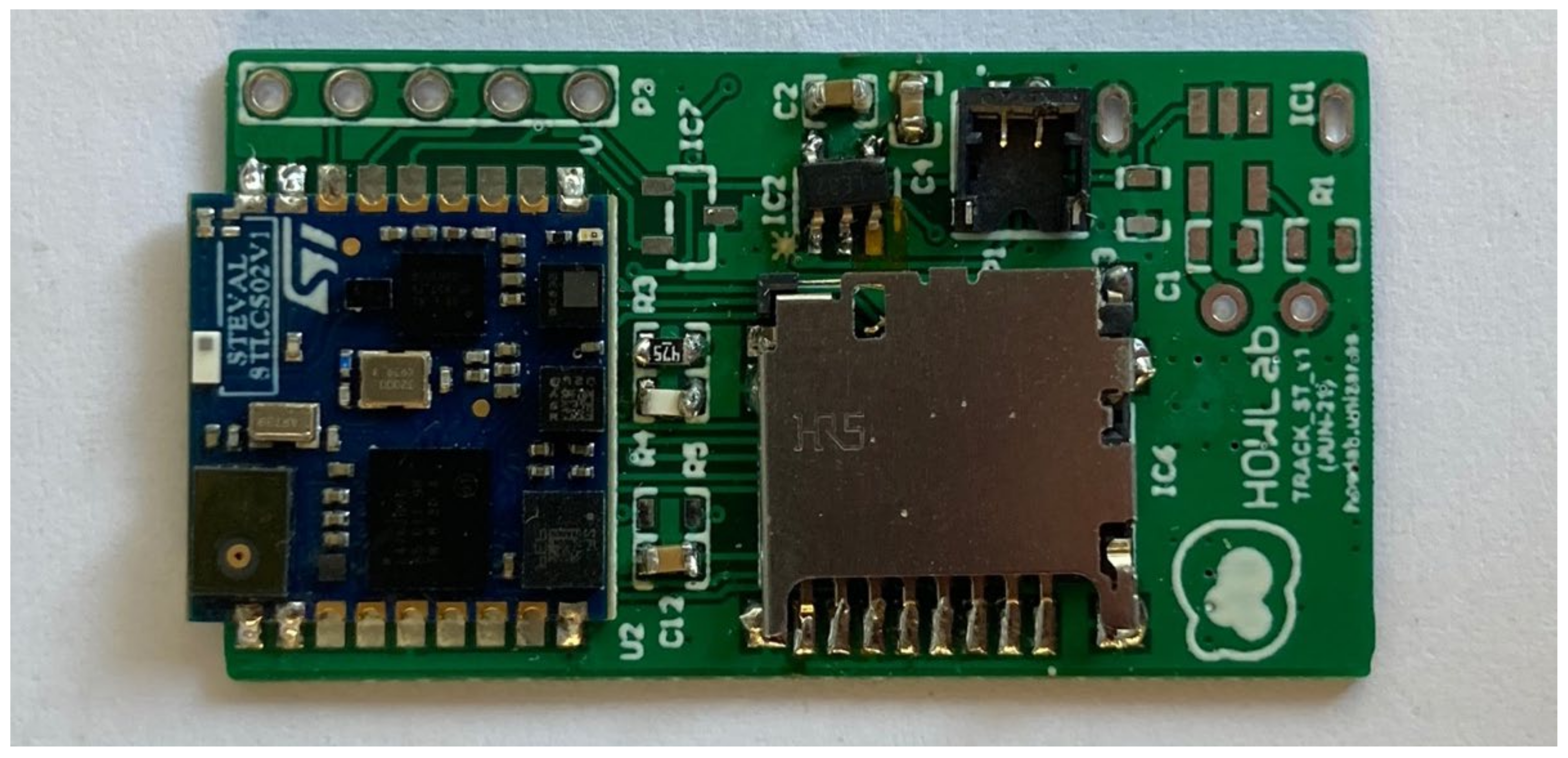
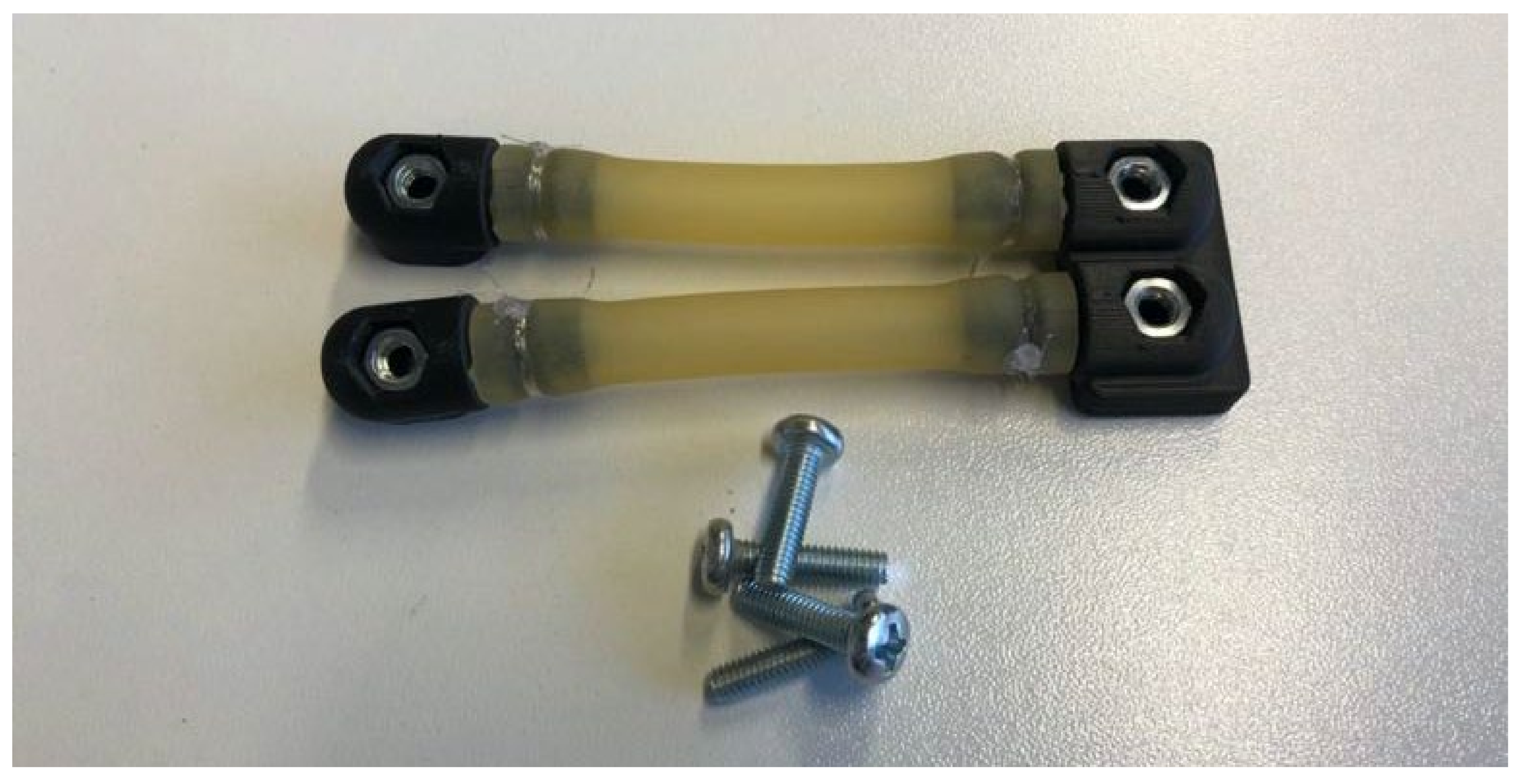
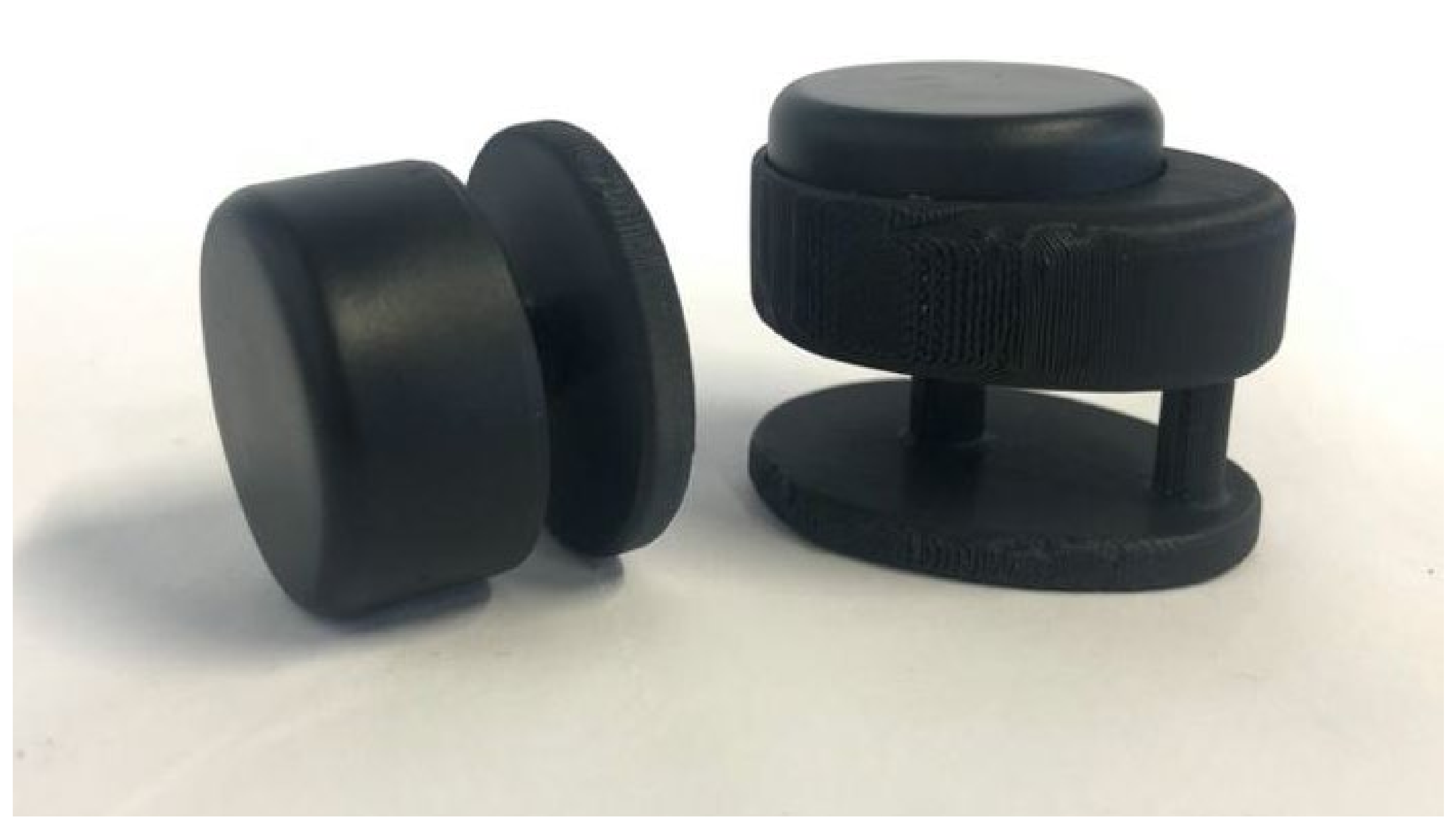
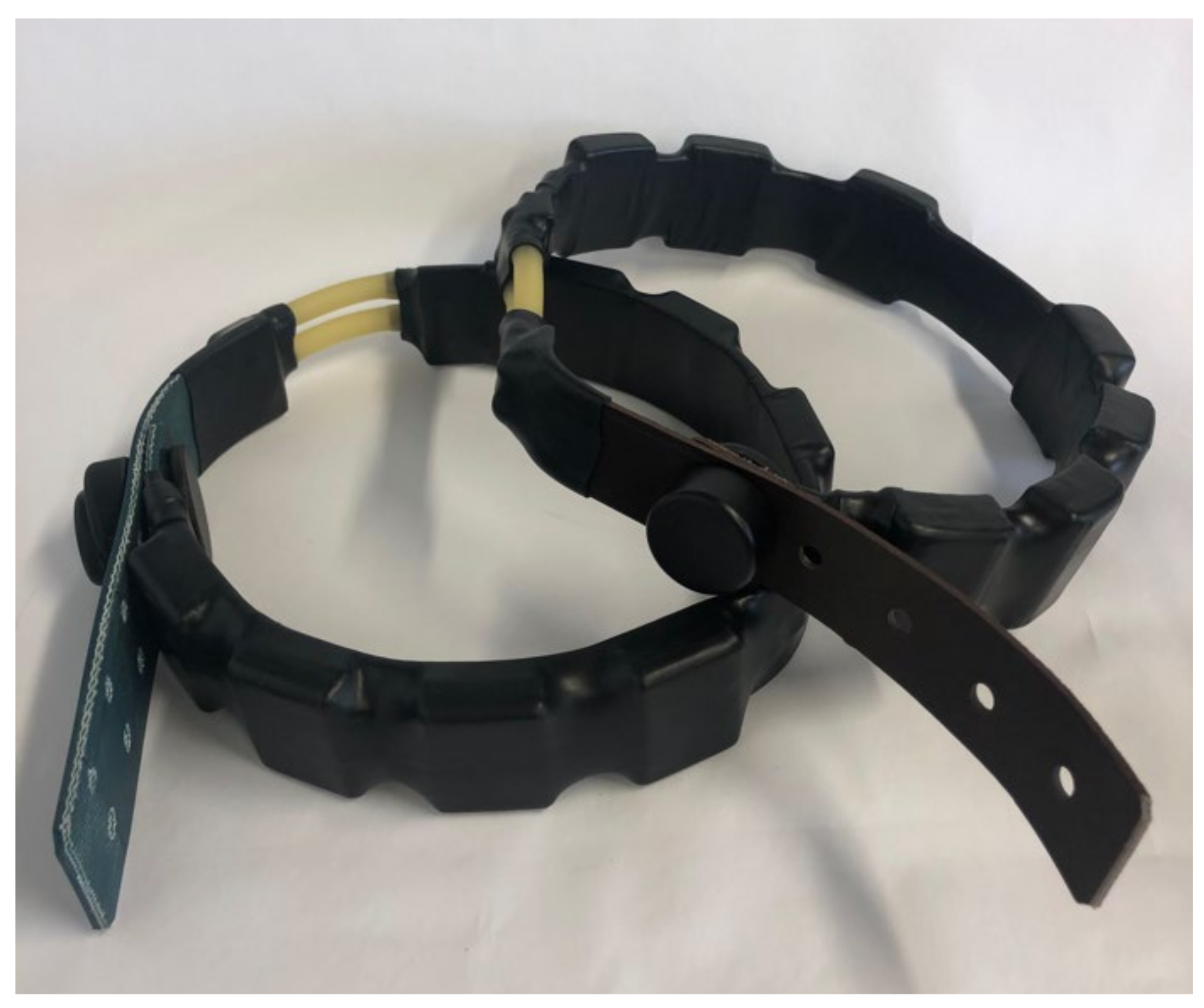
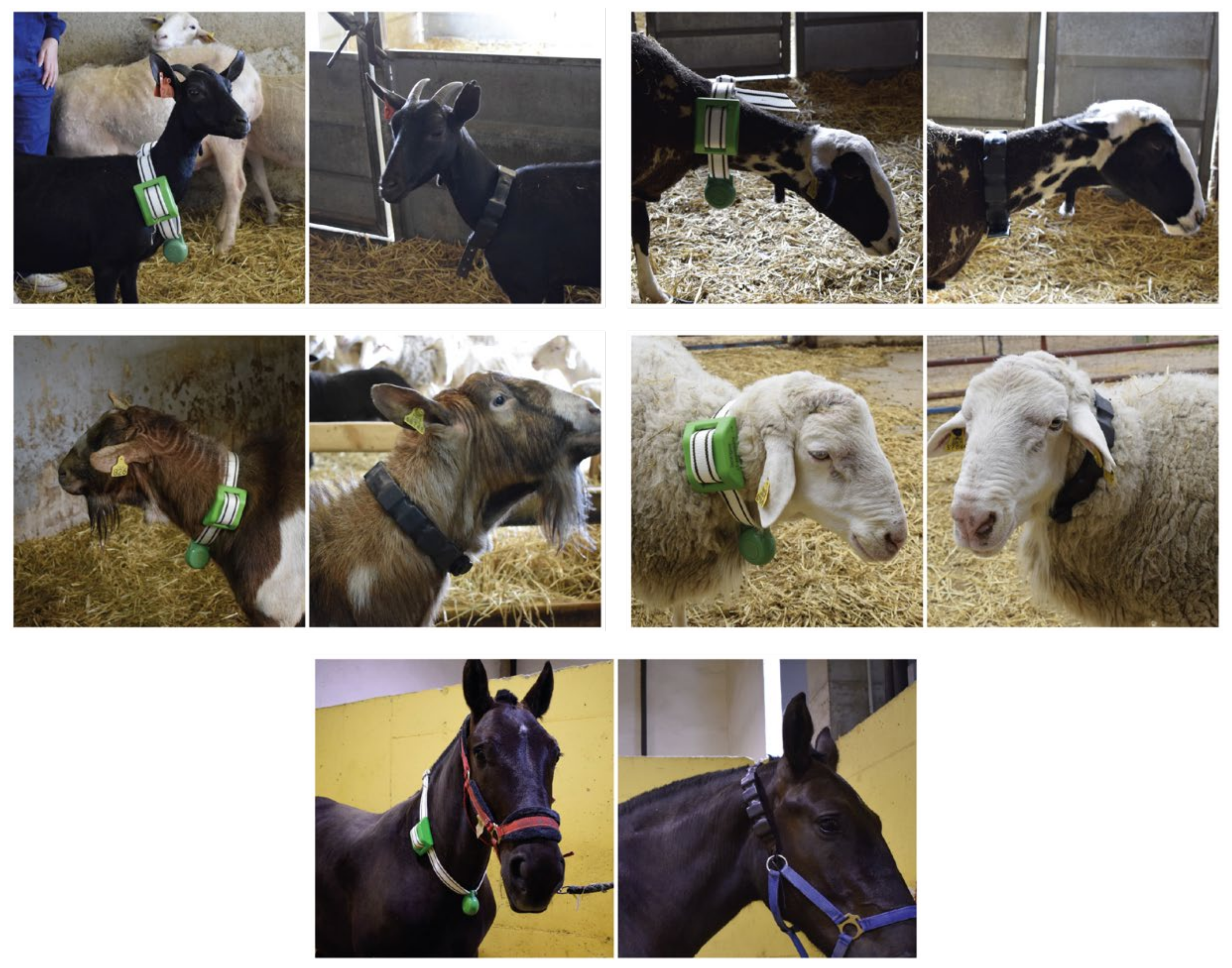
| Objective | Analysis & Source | Method |
|---|---|---|
| Obtain information from the telemetric context in which the project will be developed; and compile recommendations and solutions resulting from the investigative exercise. | State of the art from papers in scientific journals. | Literature review. |
| Extract considerations to take into account in relation to environmental conditions and use cases. | Analysis of the environment of use through semi-structured interviews with users. | Synthesis of the information according to cases of use and location of the animals. |
| Define user profiles; and detect their needs. | User analysis through semi-structured interviews with users. | Person method (modeling the characteristics of the different groups of users). Quotes (collect literary phrases that express the wishes or concerns of users). Team meetings to synthesize the information. |
| Define the morphometric measurements of the animals that determine the design of the device; and decide what type of device is going to be developed according to its placement. | Morphometric analysis by semi-structured interviews with users and morphometric tables. | Information synthesis. |
| Know what is currently being offered in terms of telemetric devices and what market niches or problems currently exist in it. | Market study and structural analysis from market offer and scientific papers. | Search for products by manufacturers. Synthesis of the characteristics belonging to the elements that make up a standard collar. |
| Decide what functions are going to be implemented; and define the electronic components that the wearable must have. | Functional analysis through meetings with users and with the team. | Information synthesis. |
| Define a manufacturing strategy that reduces production costs. | Manufacturing Context studied from papers in scientific journals. | Literature review. |
| Objectives to Evaluate | Source 1 | Methods 2 | ||
|---|---|---|---|---|
| Elements | Strap | Material (malleability; and resistance to environmental conditions) | EE | IM + RLT + SSI |
| Width (adaptation to the morphometry of the animal) | EE | IM + RLT + SSI | ||
| Length (adaptation to the morphometry of the animal) | EE | IM + RLT + SSI | ||
| Modules—Body | Shape (comfort for the animal) | EE + E | IM + RLT + SSI + LE | |
| Modules—Lid | Shape (comfort for the animal) | EE + E | IM + RLT + SSI + LE | |
| Coating | Adaptation to the collar | E | LE | |
| Resistance (to be worn) | EE | IM + RLT + SSI | ||
| Drop-Off | Robustness | EE + E | IM + RLT + SSI + LE | |
| Structure (change proposed) | EE + E | IM + RLT + SSI + LE | ||
| Closure | Structure (new design) | EE + E | IM + RLT + SSI + LE | |
| Ease of use | EE + RE + E | IM + FG + RLT + SSI + LE | ||
| Force applied (required for handling) | EE | IM + RLT + SSI | ||
| Unions | Weight reduction | CO | DA | |
| Body—Lid sealing | E | LE | ||
| Module—Module sealing | E | LE | ||
| Composition | Collar | Weight | EE + RE + CO | RLT + SSI + DA + IM |
| Weight distribution | EE + RE + CO + E | RLT + SSI + DA + IM + FG + LE | ||
| Integration of elements and formal and aesthetic adaptation | EE + RE + CO | RLT + SSI + DA + IM + FG | ||
| Autonomy | CO | DA | ||
| Design flexibility | CO | DA | ||
| Comfort for the animal | EE + RE | RLT + SSI + IM + FG | ||
| Ease of use | EE + RE + CO | RLT + SSI + DA + IM + FG | ||
| Interaction | EE + RE | RLT + SSI + IM + FG | ||
| Device | Weight | Weight Distribution (L × W × H mm3) |
|---|---|---|
| Our Proposal | 210 g (Collar A) 270 g (Collar B) | 7 modules: 4 large modules of (30.4 × 40.4 × 11) and 3 small modules of (30.4 × 40.4 × 8) |
| Personalized Telonics Collar | 238 g | 1 module (Approx. 55 × 38 × 28) |
| Telonics, TGW-4570-4 | 500–880 g | 3 modules (73 × 51 × 37) |
| Telemetry Solutions, Iridium GPS Collar | 125–250 g | 2 modules (-) |
| Tellus, Small Personalizable | >600 g | 2 modules (76 × 56 × 55) |
| Advanced Telemetry Systems, G2110E2 Iridium | 825 g | 2 modules (115 × 80 × 65) |
| Advanced Telemetry Systems, G5-D Iridium | 500 g | 2 modules (70 × 50 × 47) |
| Lotek, Ultimate V6C 176G | 278–325 g | 1 module (88 × 32 × 30) |
| Lotek, WILDCELL MG | 950 g | 2 modules (120 × 86 × 126) |
| Lotek, PinnaclePro L | 630–670 g | 3 modules (-) |
| Ixorigue, GPS Ixotrack | 960 g | 1 module (83 × 113 × 38) |
| Open-source collar for terrestrial animals over 8 kg [19] | 240 gr | 1 module (62 × 38 × 32) |
| Device | Autonomy Dependent On | Operational Life |
|---|---|---|
| Our Proposal | (at least) 3 modules | Intensive monitoring Smart mode + Activity + Bluetooth Low Energy (BLE) + Sending data—91 days |
| Remote monitoring Smart mode (24 gps/day) + Activity + BLE—236 days Smart mode (4 gps/day)—2021 days | ||
| Personalized Telonics Collar | 1 module | - |
| Telonics, TGW-4570-4 | 1 module | 4 gps/day, No Very High Frequency (VHF)—6.2 years 4 gps/day, VHF 4 h/day—5.1 years |
| Telemetry Solutions, Iridium GPS Collar | 1 module | - |
| Tellus, Small Personalizable | 1 module | - |
| Advanced Telemetry Systems, G2110E2 Iridium | 1 module | VHF on 8 h/day, 12 locations/day—3 years VHF on 8 h/day, 3 locations/day—4 years |
| Advanced Telemetry Systems, G5-D Iridium | 1 module | VHF on 8 h/day, 6 locations/day, uplinked every 2 days—4 years |
| Lotek, Ultimate V6C 176G | 1 module | 60 ppm VHF—776 days |
| Lotek, WILDCELL MG | 1 module | 50 min between gps fixes. An SMS message is sent after 7 acquired gps fixes—2 years |
| Lotek, PinnaclePro L | 1 module | VHF beacon is set to operate for 1 h a day at the average. The collar transmits through Iridium after collecting 18 positions, 7 positions/day—4 years |
| Ixorigue, GPS Ixotrack | 1 module | 24 gps/day—1 year |
| Open-source collar for terrestrial animals over 8 kg [19] | 1 module | 24 gps/day—103 days |
| Device | Unions Weight (g) 1 |
|---|---|
| Our Proposal | 1.05 g (0.15 × 7 pieces)—7 pieces of double-sided tape |
| Personalized Telonics Collar | 1.2 g (0.15 × 8 pieces)—4 double-sided rivets |
| Telonics, TGW-4570-4 | 3.6 g (0.15 × 24 pieces)—12 double-sided rivets |
| Telemetry Solutions, Iridium GPS Collar | - |
| Tellus, Small Personalizable | 30.4 g (7.6 × 4)—16 pieces, 4 base sets with rods, plate and 2 self-locking nuts |
| Advanced Telemetry Systems, G2110E2 Iridium | 22.8 g (7.6 × 3)—12 pieces, 4 base sets with rods, plate and 2 self-locking nuts |
| Advanced Telemetry Systems, G5-D Iridium | 15.6 g (2.6 × 6) 12 pieces, 6 sets of screw + self-locking nut |
| Lotek, Ultimate V6C 176G | - |
| Lotek, WILDCELL MG | 15.2 g (7.6 × 2)—8 pieces, 4 base sets with rods, plate and 2 self-locking nuts |
| Lotek, PinnaclePro L | 31.2 g (2.6 × 12) 24 pieces, 12 sets of screw + self-locking nut |
| Ixorigue, GPS Ixotrack | It does not use mechanical unions to fix the module to the strap, however, it does use a shot on the bottom part of the collar (500 g) to keep it in the correct position. |
| Open-source collar for terrestrial animals over 8 kg [19] | 10.4 g (2.6 × 4) 8 pieces, 4 sets of screw + self-locking nut |
| Device | Ease of Use |
|---|---|
| Our Proposal | Magnetic closure |
| Personalized Telonics Collar | Mechanical nut–screw closure |
| Telonics, TGW-4570-4 | Mechanical nut–screw closure |
| Telemetry Solutions, Iridium GPS Collar | Mechanical nut–screw closure |
| Tellus, Small Personalizable | Mechanical nut–screw closure |
| Advanced Telemetry Systems, G2110E2 Iridium | Mechanical nut–screw closure |
| Advanced Telemetry Systems, G5-D Iridium | Mechanical nut–screw closure |
| Lotek, Ultimate V6C 176G | Mechanical nut–screw closure |
| Lotek, WILDCELL MG | Mechanical nut–screw closure |
| Lotek, PinnaclePro L | Mechanical nut–screw closure |
| Ixorigue, GPS Ixotrack | Metal buckle. |
| Open-source collar for terrestrial animals over 8 kg [19] | Metal buckle. |
| Device | Integration of Elements and Formal and Aesthetic Adaptation |
|---|---|
| Our Proposal | Elements with similar thickness (8 mm the minimum and 20.5 mm maximum and the maximum is between a piece of 19 mm and another of 13 mm) distributed along the collar. A single coating. Antenna integrated in PCB, without external elements. Smooth and rounded finishes. Curvature in the body of the module that adapts to the neck of the animal. Hidden shiny elements. |
| Personalized Telonics Collar | Large main element at the bottom (28 mm). Heat shrinkable in the Drop-Off area. External antenna. Edges at the top and bottom, although rounded at the front. Curvature in the body of the module that adapts to the neck of the animal. Hidden glossy elements except for the closure. |
| Telonics, TGW-4570-4 | Large main element at the bottom (37 mm). It does not use heat shrink, the coating is sandwich type. Internal antenna. Slightly rounded edges. Curvature in the body of the module that adapts to the neck of the animal. Bright elements exposed. |
| Telemetry Solutions, Iridium GPS Collar | Great main element at the bottom. Heat shrinkable only on modules. Internal antenna. Modules with irregular shapes. No curvature in the body of the module to adapt to the neck of the animal. Bright elements exposed. |
| Tellus, Small Personalizable | Large main element at the bottom (55 mm). Without cover. Internal antenna. Modules with slightly rounded edges. No curvature in the body of the module to adapt to the neck of the animal. Bright elements exposed. |
| Advanced Telemetry Systems, G2110E2 Iridium | Large main element at the bottom (65 mm). Without cover. External antenna. Modules with slightly rounded shapes and edges. With curvature in the body of the module to adapt to the neck of the animal. Bright elements exposed. |
| Advanced Telemetry Systems, G5-D Iridium | Two large main elements at the bottom (47 mm). Without cover. External antenna. Modules with slightly rounded shapes and edges. With curvature in the body of the module to adapt to the neck of the animal. Bright elements exposed. |
| Lotek, Ultimate V6C 176G | Large main element at the bottom (30 mm). Heat shrinkable coatings in specific locations. External antenna. Modules with slightly rounded edges. With curvature in the body of the module to adapt to the neck of the animal. Hidden glossy elements except for the closure. |
| Lotek, WILDCELL MG | Large main element at the bottom (126 mm). Without cover. Internal antenna. Module with robust and slightly rounded shapes, lid-body closure not visually integrated. With curvature in the body of the module to adapt to the neck of the animal. Bright elements exposed. |
| Lotek, PinnaclePro L | Great main element at the bottom. External antenna. Module with robust shapes and sharp edges. With curvature in the body of the module to adapt to the neck of the animal. Bright elements exposed. |
| Ixorigue, GPS Ixotrack | Large main element at the right side (38 mm). Without cover. Internal antenna. Module with robust and slightly rounded shapes, lid-body closure not visually integrated. No curvature in the body of the module to adapt to the neck of the animal. No shiny elements exposed except the closure. |
| Open-source collar for terrestrial animals over 8 kg [19] | Large main element at the bottom (32 mm). Without cover. Internal antenna. Edged module. With curvature in the body of the module to adapt to the neck of the animal. Bright elements exposed. |
Publisher’s Note: MDPI stays neutral with regard to jurisdictional claims in published maps and institutional affiliations. |
© 2021 by the authors. Licensee MDPI, Basel, Switzerland. This article is an open access article distributed under the terms and conditions of the Creative Commons Attribution (CC BY) license (https://creativecommons.org/licenses/by/4.0/).
Share and Cite
Siguín, M.; Blanco, T.; Rossano, F.; Casas, R. Modular E-Collar for Animal Telemetry: An Animal-Centered Design Proposal. Sensors 2022, 22, 300. https://doi.org/10.3390/s22010300
Siguín M, Blanco T, Rossano F, Casas R. Modular E-Collar for Animal Telemetry: An Animal-Centered Design Proposal. Sensors. 2022; 22(1):300. https://doi.org/10.3390/s22010300
Chicago/Turabian StyleSiguín, Marta, Teresa Blanco, Federico Rossano, and Roberto Casas. 2022. "Modular E-Collar for Animal Telemetry: An Animal-Centered Design Proposal" Sensors 22, no. 1: 300. https://doi.org/10.3390/s22010300
APA StyleSiguín, M., Blanco, T., Rossano, F., & Casas, R. (2022). Modular E-Collar for Animal Telemetry: An Animal-Centered Design Proposal. Sensors, 22(1), 300. https://doi.org/10.3390/s22010300







